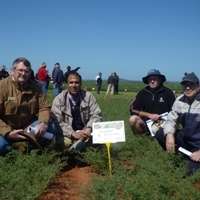New chickpeas set to revive Australian pulse industry

Two new varieties of chickpea developed by researchers at The University of Western Australia are expected to take the Indian market by storm and turn the tide for an industry that has struggled to recover from a devastating disease that first hit the Western Australian crop in 1999.
WA's chickpea industry grew rapidly from the mid-1990s and rose to be a significant 70,000 hectare grain legume crop until the arrival of the fungal disease ascochyta blight 13 years ago devastated the industry.
In 2005 an alliance between UWA, the Department of Agriculture and Food WA (DAFWA), the Council of Grain Growers Organisation (COGGO) and the International Crops Research Institute for the Semi-Arid Tropics (ICRISAT) developed a program to accelerate the genetic improvement of desi chickpea. It aimed to develop high yielding, good quality and ascochyta blight resistant varieties to put the chickpea industry back on track.
Within a short period, thousands of potential breeding lines were developed. The first two new desi chickpeas (a smaller higher fibre variety cultivated mostly in the Indian subcontinent) named Ambar and Neelam were commercially released this month at the Mingenew-Irwin Group field day, 400 kilometres north of Perth.
The Ambar and Neelam varieties have been developed by UWA Professor Tanveer Khan of the Centre for Legumes in Mediterranean Agriculture/UWA Institute of Agriculture and Hackett Professor Kadambot Siddique of the UWA Institute of Agriculture through a UWA based project in partnership with DAFWA and COGGO.
Both names are in Hindi/Urdu and have been chosen for the export market. Ambar stands for the gem "amber'' and Neelam for ''blue sapphire''.
Ambar is an early flowering variety that gives competitive yields and has high degree of ascochyta blight resistance. Its bushy growth habit and profuse branching enables it to give very high yields under good growing conditions and fits well in niche areas. Its earliness allows easier crop topping.
Neelam is a mid-flowering variety with a wide adaptation and it has given outstanding grain yields at trials in Western Australia, South Australia and Victoria. This variety has good plant height, good average seed size and attractive seed appearance for marketing. Neelam was the highest yielding desi chickpea variety at the 2010 National Variety Trials.
Both Ambar and Neelam's resistance to the ascochyta blight has been verified in other parts of Australia and India, where pathogen population is much more diverse. As a result, the need for little or no fungicide should significantly cut the cost of production.
"Neelam is an outstanding advance in the genetic improvement of desi chickpea. It has an unmatched combination of high yield potential, wide adaptation and a high degree of ascochyta blight resistance," Professor Khan said.
"These two new ascochyta resistant varieties should play a pivotal role in rejuvenating the chickpea industry," Professor Siddique said.
Provided by University of Western Australia



















